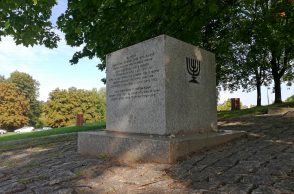The weather was fine this time – in fact, we could not dream of any better. We took an almost five-hour trip around the highest mountains in Sosnowiec. In preparation for the trip our guide spent a lot of time looking at maps in the Head Office of Land Surveying and Cartography.
Text: Katarzyna Litwinowicz, Photos: Katarzyna Litwinowicz
Thanks to this, we can be sure that indeed there are mountains in Sosnowiec and we also know how high they are. Even if not all are as spectacular as GórkaŚrodulska, still each of them is over 300 metres above the sea level. We’re sure you’ll be surprised!
Organizers:
Walking Tour ‘Crown of Sosnowiec Mountains’, Sosnowiec, 20 August 2016
Sosnowiec – Centrum Informacji Miejskiej and PTTK Odział Sosnowiec
Guide: Artur Ptasiński
Photostory

It was already at the beginning that we had to face the steepest climb, as we walked up ul. Zakopiańska

There are even more mountain-related street names in Sosnowiec, including Stroma (the one we’re actually walking right now), Góralska, Górna, Podgórna, Kukuczki, Smrekowa, Spadzista, Tatrzańska, Witkiewicza, Tetmajera…

We reached JeneralskaGóra (304 metres above the sea level). The highest point is at the place where the crane is located

According to a legend, the owner of Sielec Castle, Christian Ludwig Schimmelpfenig von der Oye, was buried at the beginning of the 19th century at the top of the mountain, with his horse and dog. Therefore the name of the top – JeneralskaGóra (General’s Mountain)

On our way to Pekin Katarzyński, we walked through ul. Kosów and passed several other bird-named streets: Słowików (Nightingale), Sowią (Owl), Bażantową (Pheasant); then we crossed ul. Kukułek (Cuckoo)

In 1990s, there were rumours of plans for building a new Sosnowiec market square in the area of ul. Klimontowska and Kukułek.

Pekin Katarzyński (Catherine Beijing), one of three ‘Beijings’ in Sosnowiec [the other two being Pekin Milowicki (Milowice Beijing) at Brynica River and Pekin Zawodzie (Zawodzie Beijing) at Bobrek River]

Pekin Katarzyński refers to meadows and fields that belonged to Sielec Farm. There was an airfield in Klimontów (or actually near Klimontów). In 1938, during the Zaolzie border conflict with Czechoslovakia, approximately 30 bomber planes were stationed here. 9 people are said to have been shot dead in this place by Germans on 4 September 1939.

The hospital was built here in 1892. Soon there was an outbreak of cholera epidemic and the hospital was turned into an infectious diseases unit. Apparently, the establishment of the cemetry at the present ul. 11 Listopada was also related to the epidemic. People who died from cholera were buried here, and the cemetry was closed for third parties. In 1918-1919, the hospital and the cemetry were full due to ‘Spanish’ flu pandemic

Górka Środulska is 319.5 metres above the sea level. “Maczki-Bór” coal mine was involved in its establishment. The ski lift was opened here in 2006

The name ‘ZagłębieDąbrowskie’ was not in use until the 20th century. Before that, the term ‘zagłębie’ (basin) would refer to a location where minerals were to be found

Chestnut tree in Mec (district of Sosnowiec). A long time ago, the majority of alleys between Klimontów and Zagórze used to be covered with chestnut trees. Now there are mainly blocks of flats

BaraniKopiec, also known as: BaraniaGórka (Ram Hill, Ram Cemetry) (310 metres above the sea level). Count JózefMieroszewski, the owner of Zagórze (current district of Sosnowiec), was a keen enthusiast of sheep and ram farming. He would invite his servants and shepherds to dinner. At the beginning of the 19th century, there was an epidemic and many animals died. They were buried in this place, and the cross was placed in gratitude for the end of the epidemic. Although the mound is made of soil, there are stones inside. Why they are there is still a puzzle

A long time ago there wasn’t a church in the area, and the local people would attend mass in Mysłowice. The legend says that Mieroszewski family decided to build a church in Zagórze to change it. The Count wanted to build it in the place of today’s BaraniaGórka, whereas his wife dreamt of having a church near the mansion where Mieroszewski family lived (which today can be seen from the area of Municipal Hospital; nowadays the palace holds an art conservation studio). Husband had his way and performed foundation excavation works, as well as ordered to begin construction. The following day it turned out that everything that had been built was already ruined. The count suspected his wife of destroying the structure. When he resumed construction and it was destroyed again, he put up a guard watch for the night. He was told by the servants that it was the rams that wreaked havoc. This turned out to be true and Count Mieroszewski agreed to build the church in the area selected by his wife.

For this reason, St. Joachim’s Church is not located on a hill, as is usual for churches, but slightly lower

There might have also been a pagan temple on BaraniaGórka – a shrine, a venue for meetings and prayers of Slavs in the old times

A concrete prefabricated unit near BaraniaGórka and St. Joachim’s Church is what remained of the uncompleted plans for establishing a landing strip for hospital helicopters

Unknown Soldier Monument was dedicated to the inhabitants of Zagórze who fought during WWI and Polish-Soviet War in 1920. Germans ordered to destroy it, however, the people appointed to do it decided to transport and hide the monument in Las Zagórski (Zagórski Forest). In 1940, Red Army brought back the obelisk (which was in a very bad condition), however, for political reasons it could not be returned to its original location for a long time. Later, the monument was being restored in Mieroszewski Palace over the period of several years (e.g. a new gun was added to the monument) and finally unveiled again in 2014

In the previous location of the obelisk, there is a cross brought here from the area of the crossroad between ul. Lenartowicza and ul. BraciMieroszewskich; therefore, the monument was placed near the cross

We also visited St. Joachim’s Church in Zagórze. The temple consists of two parts: the older one, plastered, was built in 1848. It was funded by Jadwiga Mieroszewska. As the parish was growing, the decision to expand the church was taken in 1893

A ground-penetrating radar research performed in 2009 indicated that at the joint between the old and the new church, there is a crypt with the bodies of Count Mieroszewski, his wife Jadwiga and probably their two or three children. Once there used to be a window through which you could have looked inside the crypt.

There is a chapel not far from St. Joachim’s Church. Its date of construction is not known. Was it an Aryan church? Or was it built illegally? The chapel was even thought to be visited by the souls of the deceased at night

In 1960s, the building was a ruin; in 1980s, it was partly secured and its shape of windows was changed: instead of Gothic windows there are apertures through which little light enters. At the turn of the centuries, the members of the World Union of Home Army Soldiers in Sosnowiec, with the support of the City Hall, began to restore the chapel

We entered the municipal hospital area to see the Mieroszewski Palace for guests, built approximately in 1915-1930. Currently it holds an art conservation studio. When the hospital was being built, there were plans to demolish the palace

A cave in Mieroszewski Park, currently a shelter of homeless people. The theory saying that the stone had been brought here from Ojców was eventually rejected. The legend says that the underground dungeons led as far as to Będzin Castle.

According to the maps available at the Head Office of Land Surveying and Cartography, this spot is the highest point in Sosnowiec (322.6 metres above the sea level). It doesn’t have its name. The local inhabitants refer to this area as ‘Leszcze’ or ‘Kamionka’

Former ul. Leśna, where the house of Mr Kowalski is located, used to bear the name of ul. RewolucjiPaździernikowej (October Revolution), then ul. 27 Stycznia (27 January), and its current name is ul. RomanaDmowskiego. The house was built around 1890

Location of a failed assassination attempt against Nikita Khrushchev in 1961. The bomb was placed in a tree branch near Militia station (grey building on the right)

In 1826, there was already an open-pit mine, connected with ‘Porąbka’ coal mine. There was a steam machine here. Currently there is a gym in the building. The owners decided to leave the mining emblem
































